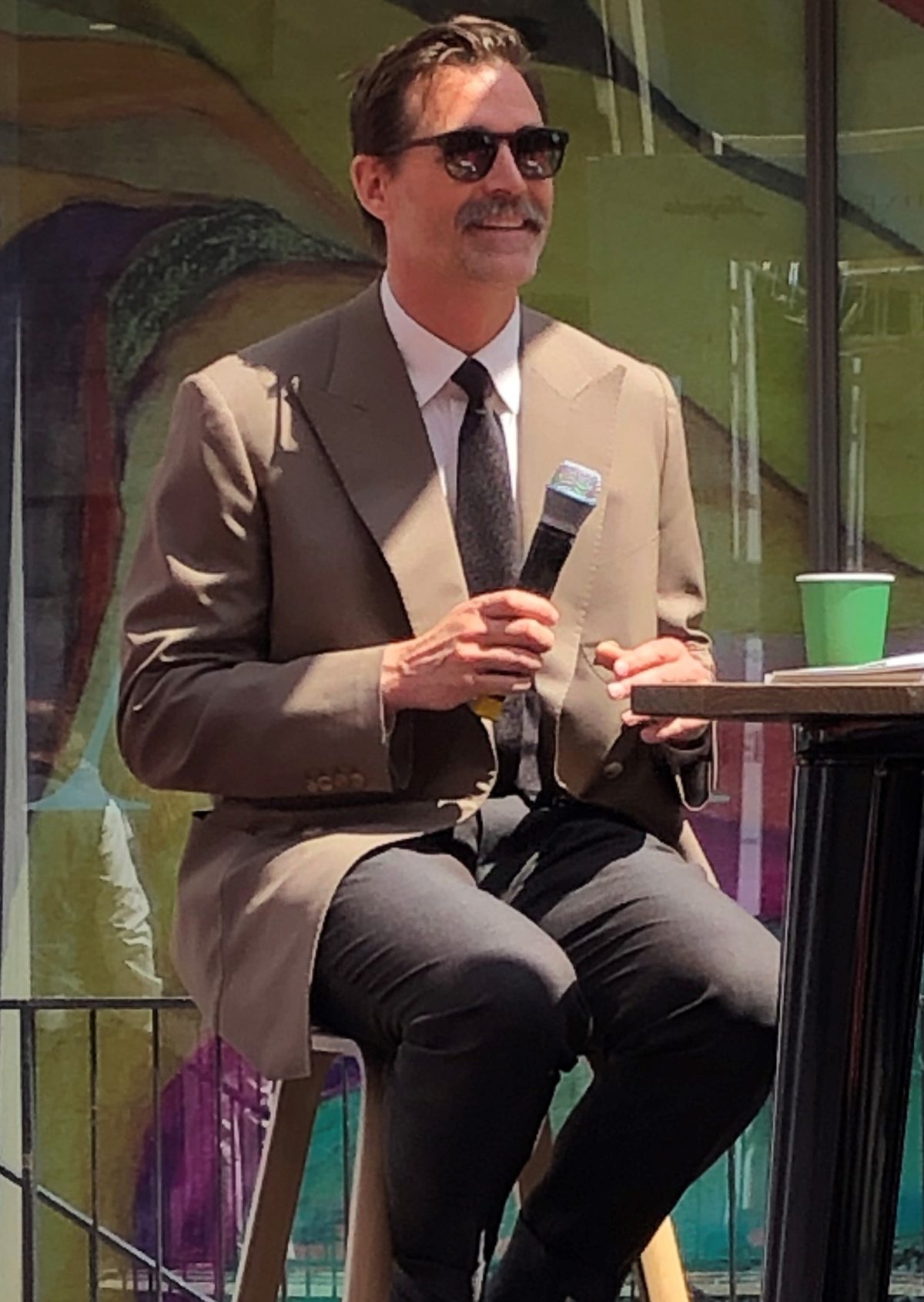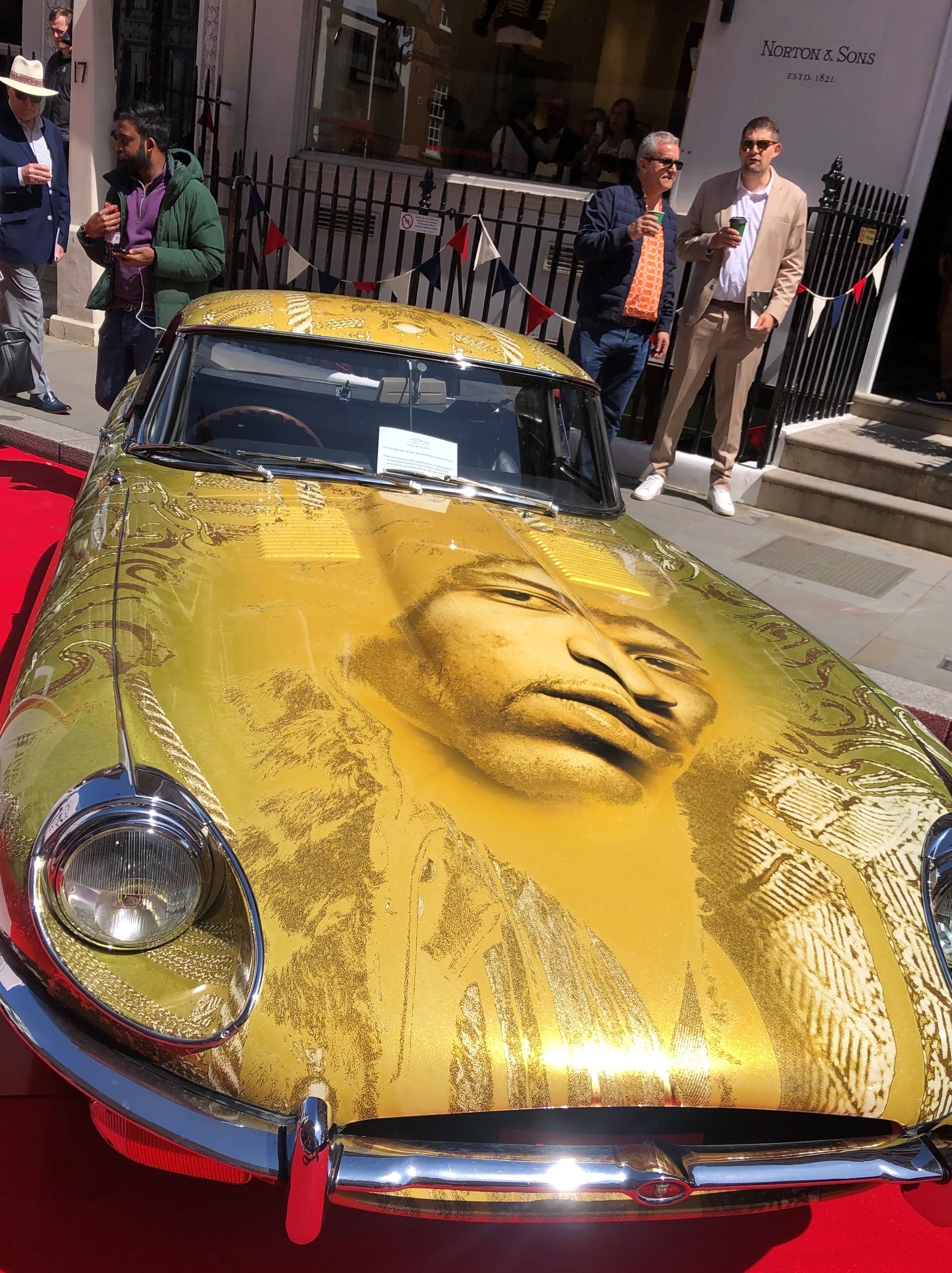
By Daniel Evans
As the sun beats down on Savile Row, bouncing off the prestige and classic cars on display outside Britain’s finest tailoring establishments, Patrick Grant, director of Norton & Sons, is very much in his element. He is delighted to see the Row packed with enthusiasts of both fine clothing and exotic cars as the second Savile Row Concours gets underway and he feels the future is looking good for the home of high-class tailoring.  “I started at Norton’s in 2005 and, back then, the number of young people looking for apprenticeships on this street was pretty low,” he says. “We probably got one person a month coming in to ask about apprenticeships. I was then involved with a BBC documentary about Savile Row which sparked a lot of interest. After it went out, the phone was ringing off the hook. Making things is becoming cool again and I think, for many young people, a job with your hands where you are using your skill and your brain to produce something of exquisite quality is now seen as a cool job to have in a way for a long time it wasn’t.
“I started at Norton’s in 2005 and, back then, the number of young people looking for apprenticeships on this street was pretty low,” he says. “We probably got one person a month coming in to ask about apprenticeships. I was then involved with a BBC documentary about Savile Row which sparked a lot of interest. After it went out, the phone was ringing off the hook. Making things is becoming cool again and I think, for many young people, a job with your hands where you are using your skill and your brain to produce something of exquisite quality is now seen as a cool job to have in a way for a long time it wasn’t.
“After we made that documentary, there was an immediate change in the number of people who were coming to apply for jobs here. We went from about one a month to two or three a week. Now, happily for Savile Row, the position with apprenticeships is very buoyant. There are far more people applying for apprenticeships than we have places to teach.”
Patrick is certainly one of the more high profile tailors on the Row. As well as his involvement with Norton & Sons, he fronted a TV documentary about military uniforms ahead of the Coronation, has been presenting The Great British Sewing Bee since 2013 and is currently doing some work with King Charles (about which more later).
First, Patrick tells how he became involved with Norton & Sons. “I was finishing off my post grad and I happened to be reading the Financial Times and there it was, at the back in the businesses for sale section,” he recalls. “I couldn’t believe it! There was this little advert – For Sale, tailors to emperors, kings and presidents. I thought this can’t be real but it was. I flogged everything I could find to sell, including my house and my car.
“This year, we are 202 years old which makes us one of the oldest tailors on the street. We have always done tailoring. It’s a wonderful business. We’ve never been one of the big, shouty ones. It’s always been the one that connoisseurs will track down. We’ve enjoyed being almost under the radar but not quite. We were big on making clothes for people who travelled and explored. Even today we have some customers who are polar explorers and people who do mad things like take pianos to tribes in the middle of the Amazon.
“Lord Carnarvon was a customer so Tutankhamun’s tomb was opened by a man wearing a lightweight suit – although it didn’t look that lightweight, to be honest. It looks like it’s about 25 ounces from the photographs. We’ve always made lightweight, unstructured stuff. Everyone thinks the Italians were the only people to do lightweight tailoring but Brits, for good reason and for bad, spent a lot of time in hot places and they needed clothes to wear too and Norton’s was one of the houses that specialised in lightweight, unstructured stuff that you could wear in countries where it was 40 degrees all the time. We still have those skills in-house today.”
Patrick knows the fashion industry does not have a good reputation when it comes to green credentials and is aware that sustainability has shot up the agenda. “We need to buy fewer things,” he says. “We need to consume less and we need to consume better things that are going to last longer and are not going to have any damaging effects on the environment on the way in and certainly aren’t going to have any damaging effects on the environment on the way out.
“We need to get out of the habit of buying lots of inexpensive things. The inexpensive stuff has got so cheap. You can go and buy a pair of shoes for a tenner – polyurethane top glued on to a plastic bottom. Horrible stuff that’s doing terrible things to the environment at every stage of its production then when the sole falls off, which it will do after you’ve worn it about three times, it goes in the bin and ends up in landfill and never biodegrades. Instead of that, you could get a pair of shoes that are made out of something that’s a by-product of our food industry, that’s totally natural and biodegradable and will last you for ages and every time it needs repairing, you can take it to somebody who can fix it for you. So, you’re putting more money into the economy. 
“I still have a dinner suit of my dad’s which was made in the 1930s by a tailor in Edinburgh. It’s a bit agricultural but it is bombproof. I wore it all through university, both under grad and post grad, I’ve crawled through hedges backwards in it but you give it a brush and it looks as good as new. It’s coming up for its 90th birthday and it’s still in perfect nick. I’ve got a couple of other pieces from my dad which were made in the 1930s and jackets from my grandad made in the 1950s which are still great. It’s not just that the clothes are good but the more you wear these things, they pick up history and become part of the story of your life, your interactions with your friends. We can remember wearing things at a particular occasion and that gives them value too. Every time you repair something, it adds to its value.”
Patrick saw a great example of longevity while he was making the programme about uniforms for the BBC ahead of the Coronation. “As part of that documentary, we went to a firm in Birmingham called Firmin which makes buttons. It’s the most incredible place on earth. There is equipment in that factory which dates back to the 1650s. They help make the Household Cavalry helmets and they have an old blacksmith’s elm that was there when the business was formed in 1655 and they still use it. After seeing it on TV, a lot of people got in touch, all saying the same thing: ‘Isn’t all of this craft wonderful and shouldn’t we all do more to preserve it?’ Of course we should, but that means putting your money where your mouth is. Don’t buy ten cheap things, buy one good thing and care for it. Make it last and enjoy it because you will enjoy wearing that one good thing so much more than ten inexpensive things.”
More recently, Patrick has talked about working with King Charles. “I’ve met him on many occasions,” says Patrick. “He is a lover of beautiful things – a lover of clothes and a lover of craftsmanship. He is a great example of how to live with stuff for a very long time. He was having some new dress shoes made by Tricker’s (in Northampton) but he loved the ribbon on his old dress shoes so he asked Tricker’s to take the ribbon off the old shoes (which were probably around 50 years old) and put them on his new shoes. It was the connection with the past, with everywhere those old shoes would have been. There’s something intangible there that adds to the value of our clothes – the more we wear them, the more we keep them.”
In 2018, Patrick became co-chair of the Prince of Wales’ charity Future Textiles, an organisation that works towards creating jobs in the UK’s garment making industry. “It’s an amazing charity,” explains Patrick. “It teaches young people to sew. The main sewing school is in Dumfries House up in Ayrshire. So far, we’ve taught more than 6,000 kids how to sew. They come for a day or they come for a week and they learn how to sew with some brilliant people. We’ve also got a sewing school at Trinity Buoy Wharf in east London and now we have a school in the King’s home at Highgrove in Gloucestershire. The King believes we should all know how to fix our clothes and do these basic things so he set up a school to teach people to do it.”
As the crowds continue to teem up and down, Patrick’s words of optimism regarding the future health of the Row sound well founded. “Savile Row is unique because everyone understands that what we do here is incredibly special. People are prepared to pay for the skill of those who are making your suit,” he says. “Everyone who is a customer on Savile Row appreciates what that is worth – it is the skill of the human beings who crafted that suit, the skill of the weavers who have created that cloth, and the finishers and the spinners, and the famers who have raised the sheep or have grown the cotton. All of that stuff we need to value in a very different way. We’re lucky on Savile Row because people already do value it but we need to learn to have that same respect for craftsmanship and materials in everything we buy and ensure that Savile Row remains the absolute pinnacle of hand tailoring anywhere on the planet.”








